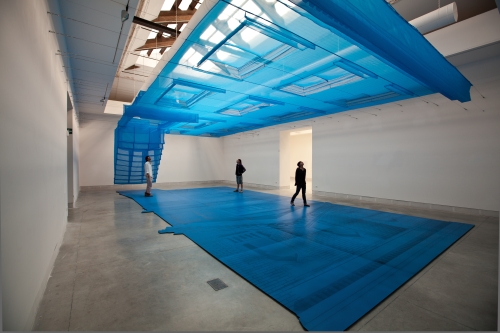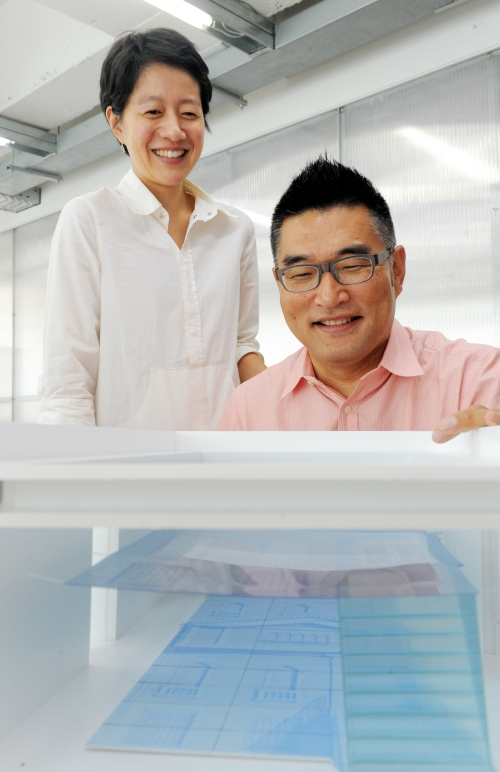Two Korean brothers will be showcasing a mix of art and architecture at the 2010 Venice Biennale International Architecture Exhibition, which kicks off on Aug. 29.
Suh Do Ho, a renowned installation artist, was invited to the exhibition by director Kazuyo Sejima who had always admired his works, and chose Suh Architects ― an architecture firm run by his younger brother Suh Eulho and his sister-in-law Kim KyungEn ― to be his partner.
This is the first time a Korean team has been invited to the main exhibition of the event where world famous architects and artists like Rem Koolhaas and Olafur Eliasson show their works.
“Sejima won the Pritzker Prize this year and invited all the best architects and artists. We are honored to have been invited in the International pavilion, and it is extra meaningful because we get to do it with my brother. You know, just like the theme of the Biennale, ‘People meet in architecture,’” Suh Eulho told The Korea Herald at his office in Hannam-dong on Tuesday.
The work, titled “Blueprint,” is a combination of a 12.7 meter-long translucent fabric façade of a New York town house floating right under a ceiling suspended vertically and a floor installation comprised of CNC routed high pressure laminate panels which is supposed to be the façade’s shadow. Both parts are imbued in cobalt blue color.
The ‘ceiling,’ which is a one-to-one scale translation of Suh Do Ho’s current apartment in New York, is a part of the series in which the artist recreates the buildings he has lived in.
The ‘shadow’ was created by Suh Architects. Kim said that deciding on what to do was very challenging.
“Suh Do Ho’s works have enough presence to fill the room. It didn’t seem appropriate for us to come up with a secondary object. We didn’t want to compete with his work but to augment it. We had a couple options and finally came up with the idea of a fictive reflection,” explained Kim.
It is fictive because it is not just a reflection of the New York apartment but also has the hanok in Seongbuk-dong where the two brothers grew up and some typical Venetian windows embedded in it. It captures Suh brothers’ past, Seoul, present, New York, and future, Venice.

“Blueprint” by Suh Do Ho and Suh Architects Suh Architects
“We like the irony that the shadow is actually a hard object, which you can walk on and the actual façade is an ephemeral thing that is flowing in the ceiling. It is an unbelievable composite that would actually never happen. This collaboration questions the boundary between real and reflection; art and architecture; and where one once was, now is, and soon will be,” said the younger Suh.

Kim KyungEn (left) and Suh Eulho show a model of “Blueprint.”Ahn Hoon/The Korea Herald
Their participation in the Biennale was only decided in late March so the team was really pressed for time. Moreover, Suh Do Ho was hardly in Korea, but busy working in Germany and the U.S., so the three had to rely on e-mails, webhards and Blackberries.
“Both of the brothers are extremely meticulous. Mediating between the opinions of us three was the most difficult part,” said Kim, smiling. Suh said that Kim, who had shifted her major from sculpture to architecture, understood both the mindset of an artist and an architect and worked as a great bridge between the two Suhs.
The whole family, in fact, is composed of architects and artists. Suh’s father is Suh Se-ok, a veteran painter, and Kim’s father is an architect who was one of the first Koreans to study at Harvard.
“Everyone (in our family) is able to communicate with each other really well, and criticize about the critical points, straight down. I think that is how we were able to bring out a solidified work despite all the long distance discussions,” said Suh.
Suh brothers’ love and interest for houses was perhaps meant to be. The Seongbuk-dong hanok featured in “Blueprint” is a model of the actual house they grew up in. Their parents still live there and Suh Do Ho spends time there when he is in Korea.
Their father built the hanok at the time of Korea’s rapid modernization in the 1970s when so much Korean traditional architecture was being demolished.
“He built the house to resemble Yeongyeongdang, a small hanok in Changdeokgung, built during Sunjong’s reign. Yeongyeongdang is one of the most beautiful buildings among Korean architecture. It is so pure and natural. My father bought the actual wood that was used in the palace to build the house,” said Suh.
It took eight years to build it as they had no electricity, no nails and took their time, stopping for a while whenever they were short of money or wood or when it rained. Bae Hee-han, the carpenter who built it, became an intangible cultural asset afterwards.
“To me, the Seongbuk-dong house seemed to be remote from reality, and I felt like I was stepping into another world every time I went out. Perhaps that is why I didn’t feel much difference when I went to the U.S. at a young age. Because my father is a painter, my family didn’t talk about golf or stocks like other families but enjoyed talking about trees, flowers, moss and pictures. I think it helped develop my ability to observe. So in that sense, it is true that we grew up in a different environment from other people,” said Suh.
Architect Seo once inserted his older brother’s installation work in a proposal for a building’s renovation ― and inked the deal ― but this is the first time they have created something together from scratch.
2010 Venice Biennale International Architecture Exhibition runs from Aug. 29 to Nov. 21 at Castello Gardens and Arsenale in Venice, Italy.
By Park Min-young (
claire@heraldcorp.com)







